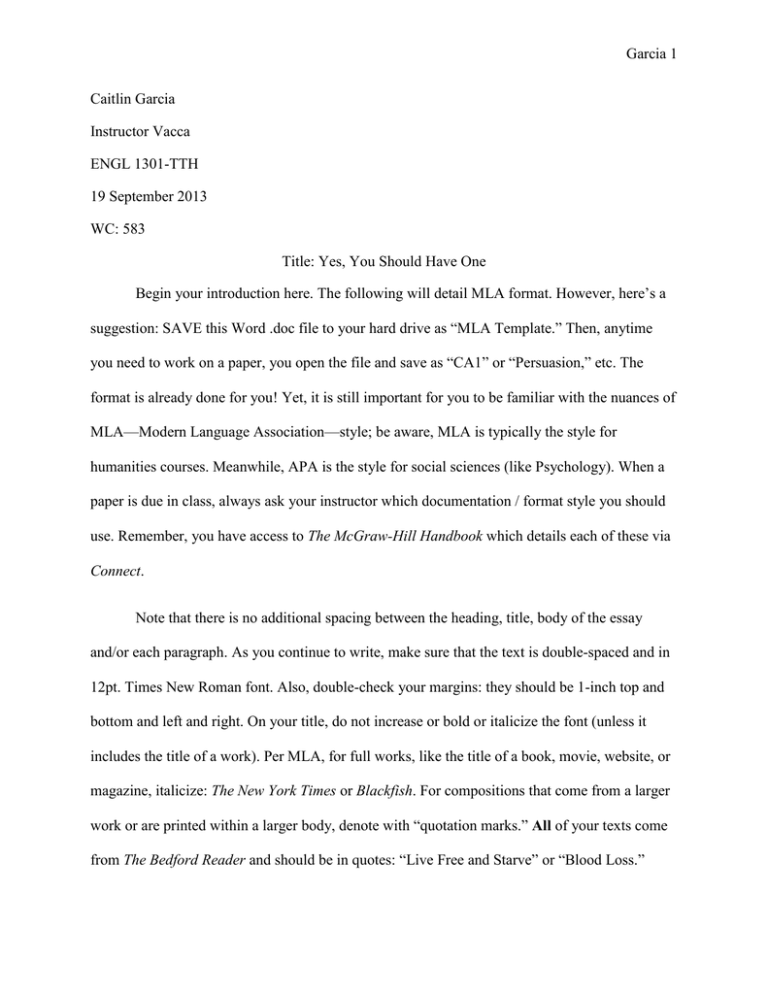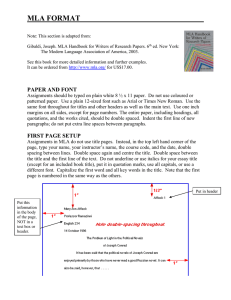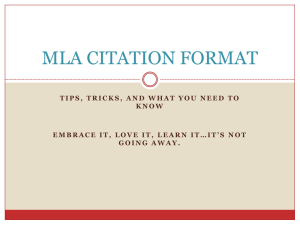MLATemplate.R15F.doc
advertisement

Garcia 1 Caitlin Garcia Instructor Vacca ENGL 1301-TTH 19 September 2013 WC: 583 Title: Yes, You Should Have One Begin your introduction here. The following will detail MLA format. However, here’s a suggestion: SAVE this Word .doc file to your hard drive as “MLA Template.” Then, anytime you need to work on a paper, you open the file and save as “CA1” or “Persuasion,” etc. The format is already done for you! Yet, it is still important for you to be familiar with the nuances of MLA—Modern Language Association—style; be aware, MLA is typically the style for humanities courses. Meanwhile, APA is the style for social sciences (like Psychology). When a paper is due in class, always ask your instructor which documentation / format style you should use. Remember, you have access to The McGraw-Hill Handbook which details each of these via Connect. Note that there is no additional spacing between the heading, title, body of the essay and/or each paragraph. As you continue to write, make sure that the text is double-spaced and in 12pt. Times New Roman font. Also, double-check your margins: they should be 1-inch top and bottom and left and right. On your title, do not increase or bold or italicize the font (unless it includes the title of a work). Per MLA, for full works, like the title of a book, movie, website, or magazine, italicize: The New York Times or Blackfish. For compositions that come from a larger work or are printed within a larger body, denote with “quotation marks.” All of your texts come from The Bedford Reader and should be in quotes: “Live Free and Starve” or “Blood Loss.” Garcia 2 When you quote word-for-word language, make sure to always cite and use quotation marks. “Inanimate objects are classified into three major categories” (Baker par. 1). OR “Inanimate objects are classified into three major categories” (Baker 399). Choose either to cite paragraph number (par.) or page number (just the number). Be consistent throughout. I could also cite the above quote like so: Baker kicks off his article with: “Inanimate objects are classified into three major categories.” Why don’t I need the parenthetical citation here? I’ve used a signal phrase: “Baker kicks off his article with.” I do not need to show the par. (paragraph number) or page number as I am clear in the signal phrase—it’s the first line. Further, I also might summarize or paraphrase—if so, I still need to cite: Baker suggests three major types of “inanimate objects” (par. 1). Make sure all quotations still flow and maintain grammar and syntax conventions. If not, you might clarify by adding in words with [brackets.] There also might be occasions where you do not want an entire passage—in order to more effectively show the material, include an ellipses … this is three periods with a space on either side. Last thing to check! Make sure you have inserted page numbers in the top right corner and add your last name to the header. Often times, Word requires you to manually enter the name versus selecting a pre-existing option. For most programs, you should be able to go to the “Insert” tab for the page number. Meanwhile, you may need to add the last name by going to the “View” tab and then selecting “Header and Footer.” Again, you will likely need to manually enter your last name. There should be one space between the name and page number; sometime the font will be different. Correct and ensure it is also in 12pt Times New Roman.




